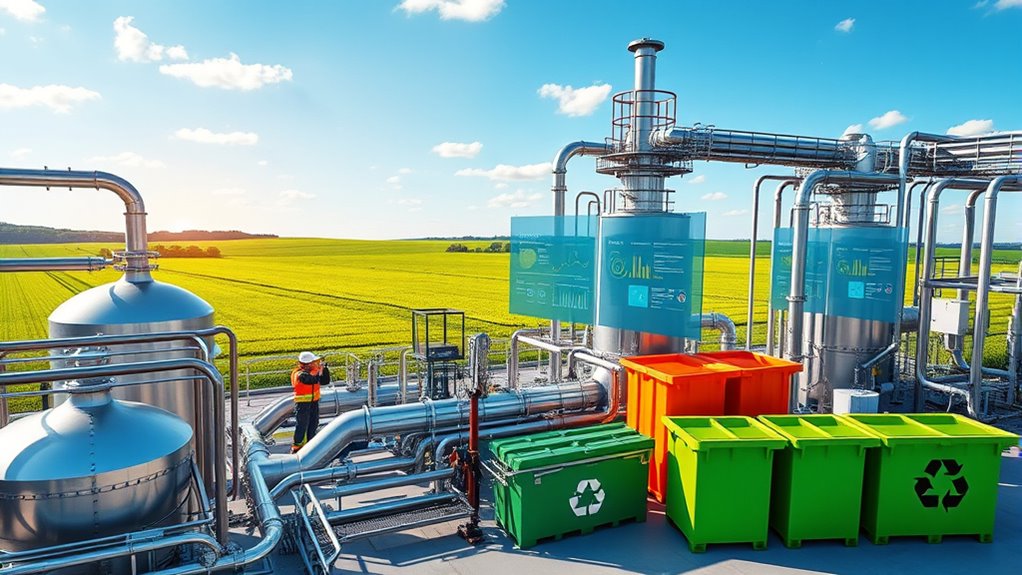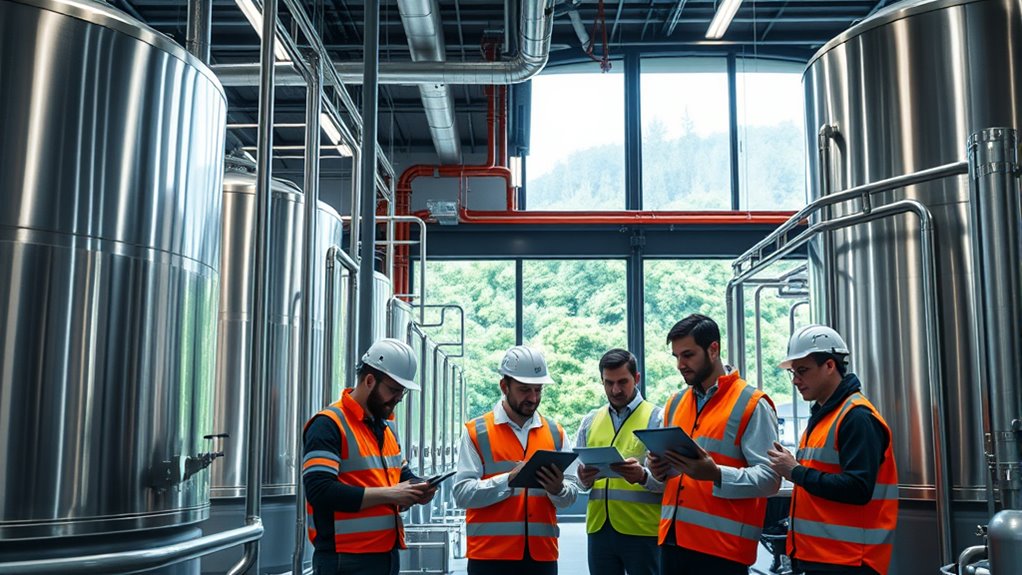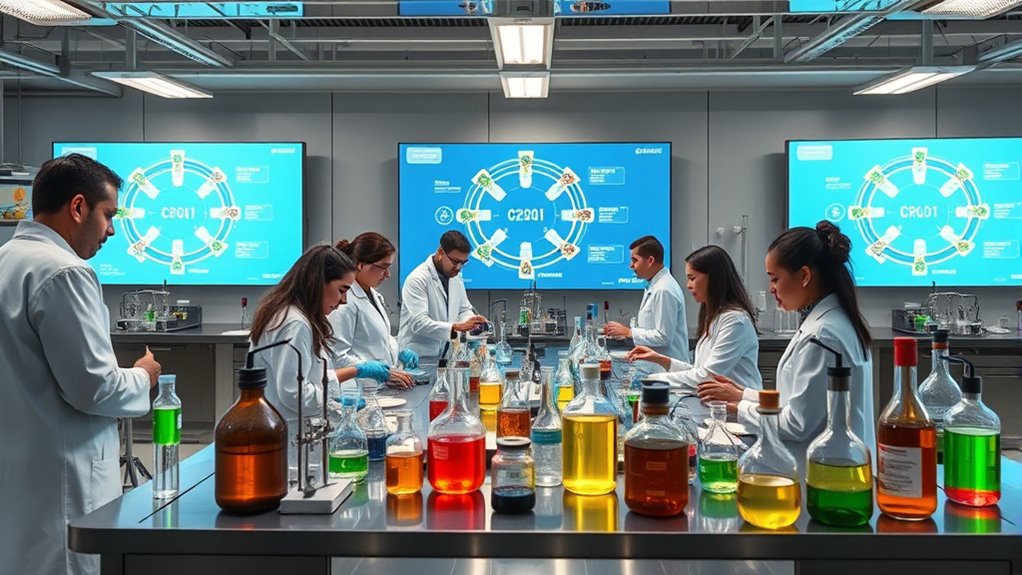Building a circular chemical economy requires you to adopt resource-efficient processes, design products for recyclability, and foster cross-sector collaboration. By turning waste into resources through advanced recycling, bio-based materials, and innovative technologies, you can reduce environmental impacts and create new business opportunities. Overcoming challenges like infrastructure gaps and policy hurdles is essential, and building ecosystems of shared expertise helps accelerate progress. If you explore further, you’ll discover how these strategies come together for a sustainable future.
Key Takeaways
- Implement closed-loop processes and maximize atom efficiency to recirculate materials and minimize waste.
- Foster cross-sector collaboration and build ecosystems to accelerate innovation and shared resource management.
- Develop sustainable product designs emphasizing recyclability, modularity, and biodegradability.
- Invest in advanced recycling, bio-based materials, and infrastructure to recover and reuse chemicals effectively.
- Establish supportive policies, standardization, and workforce training to enable industry-wide transition.
Understanding the Core Principles of Circular Chemistry

Understanding the core principles of circular chemistry is essential for transforming how you produce and manage chemicals. Instead of viewing waste as discarded material, see it as a valuable resource to be repurposed into raw materials for new products. This approach enables complete molecular and material recirculation, fostering closed-loop processes with minimal waste. Close Material Loops Supporting systems that enable material recovery and reuse in labs is also vital for implementing these principles effectively. By redirecting waste streams toward the synthesis of marketable products, you create sustainable, nearly waste-free systems that rely on energy inputs only. Maximizing atom efficiency ensures you use all atoms in molecules effectively, reducing raw material consumption and by-products. Rethinking waste management and utilization is fundamental to building a waste-free, circular chemical industry. These principles guide you toward sustainable practices that balance environmental health with economic viability, emphasizing the importance of material recovery technologies in achieving these goals.
Enhancing Resource Efficiency and Waste Valorization Strategies

To boost resource efficiency and turn waste into valuable assets, you need to adopt targeted strategies that optimize every stage of the chemical lifecycle. Conduct lifecycle assessments to identify inefficiencies, utilize digital tools to streamline processes, and implement lean manufacturing to cut waste. Increasing bio-based materials reduces reliance on non-renewables, while detailed supply chain mapping uncovers bottlenecks. Waste valorization involves advanced recycling and chemical recycling to recover valuable chemicals, energy recovery to generate fuels or electricity, and biodegradation methods to break down waste naturally. Establishing closed-loop systems ensures continuous reuse of chemical waste. Vertical storage solutions can also be integrated into waste management practices to maximize space and efficiency. Use this table to understand key strategies:
| Strategy | Focus Area | Outcome |
|---|---|---|
| Lifecycle Assessment | Efficiency across lifecycle | Reduced resource consumption |
| Recycling Technologies | Waste treatment | Material recovery |
| Bio-Based Materials | Raw materials | Sustainability improvement |
| Closed-Loop Systems | Waste management | Continuous reuse |
Furthermore, integrating these strategies with policy measures can significantly accelerate the transition toward a more sustainable and circular chemical economy.
Driving Business Value Through Circular Innovation and Models

Driving business value through circular innovation and models requires strong leadership and strategic alignment. When executives champion circular initiatives, they set the tone for cross-department collaboration, turning linear processes into value-driven ecosystems. Principles of the Circular Economy This shift not only boosts your competitive edge but also aligns your business with customer sustainability goals, creating mutual benefits. Circular models open new revenue streams like leasing, remanufacturing, and product-as-a-service, attracting eco-conscious customers and expanding market share. They also cut costs by reusing resources, extending product lifecycles, and reducing waste. Additionally, adopting circular practices enhances resilience by diversifying supply sources and lowering regulatory risks. Leveraging data from reverse logistics informs better design and customer engagement, driving continuous innovation and strengthening your position in a sustainable economy. Incorporating cost and budgeting strategies ensures the financial viability of transitioning to circular models, enabling long-term success.
Overcoming Challenges With Technology, Policy, and Culture

Implementing circular chemical solutions faces significant hurdles that must be addressed through advancements in technology, supportive policies, and cultural shifts.
Technologically, developing catalysts that operate under milder conditions, improving standardization, and tackling contamination are vital. Infrastructure gaps in recycling and emissions capture also hinder progress. Catalyst innovation is essential for enabling more efficient and sustainable chemical processes that support circularity. Additionally, the integration of recycling infrastructure is crucial for closing material loops and reducing waste.
Policy-wise, stable government support and harmonized regulations are essential to create a predictable environment that encourages investment. Without incentives for reuse and sustainable practices, progress stalls.
Financial barriers, such as high transition costs and limited funding, further slow adoption.
Collaboration across supply chains is complicated by inconsistent feedstock quality and traceability issues.
Ultimately, changing industry culture and consumer behavior is necessary to foster widespread acceptance of circular principles, ensuring these innovations are embraced and sustained.
Leveraging Sector-Specific Opportunities for Circularity

Leveraging sector-specific opportunities is essential for advancing circularity across the chemical industry. By focusing on raw materials, product design, packaging, business models, and end-of-life solutions, you can access significant environmental and economic benefits. For example, biomass and recycled materials support closed-loop systems, reducing reliance on fossil fuels. Designing products for recyclability and modularity simplifies disassembly and reuse. Using bioplastics and minimalist packaging cuts waste and resource consumption. Adopting product-as-a-service and sharing models extends product life and promotes resource efficiency. Additionally, investing in advanced recycling and biodegradation technologies guarantees materials are recovered or safely broken down at end-of-life. Implementing innovative materials and processes can further enhance circularity by transforming waste into valuable resources and reducing environmental impact. For instance, incorporating sustainable feedstocks like bio-based raw materials can significantly decrease carbon footprints. Here’s a quick overview:
| Opportunity Area | Key Actions |
|---|---|
| Raw Material Optimization | Biomass, recycled, and sustainable sourcing |
| Product Design | Recyclability, modularity, biodegradable materials |
| Packaging & Transport | Bioplastics, reusable, eco-friendly logistics |
| Business Models | Product-as-a-service, sharing platforms |
| End-of-Life Solutions | Recycling tech, biodegradation, waste-to-product |
Building Collaborative Ecosystems for a Sustainable Chemical Future

Building collaborative ecosystems is essential for creating a sustainable future in the chemical industry, as no single organization can achieve this alone. By working together, you can accelerate technological innovation—developing bio-based materials, recycled plastics, and carbon capture methods more efficiently. Industry-wide efforts toward decarbonization are prompting companies to form strategic alliances and share best practices to meet environmental goals. Sharing goals across companies, academia, and regulators helps align efforts and reduces risks, opening new economic opportunities. These ecosystems promote circular economy principles, emphasizing waste reduction and recycled materials, while fostering sustainable practices. Collaboration also speeds the adoption of innovative processes, such as catalytic recycling, and supports workforce training for green chemistry. Furthermore, unified efforts strengthen environmental and economic resilience, enabling you to better address emissions, reduce costs, and meet regulatory demands. Building a Cultural Intelligence framework within these collaborative efforts can facilitate smoother cross-sector communication and trust, driving collective progress toward a more sustainable chemical future.
Frequently Asked Questions
How Can Consumers Influence the Shift Towards a Circular Chemical Economy?
You can influence the shift toward a circular chemical economy by choosing sustainable products and supporting companies committed to eco-friendly practices.
Your awareness and demand for transparent labeling, certifications, and eco-conscious brands encourage businesses to adopt circular models.
Sharing positive experiences and advocating for policies also help.
When you prioritize recyclability and participate in community initiatives, you drive larger change, making sustainable choices a norm in the industry.
What Role Does Digital Technology Play in Enabling Circular Chemical Processes?
Digital technology plays a vital role in enabling circular chemical processes by enhancing transparency, efficiency, and collaboration.
You can track materials in real time, optimize resource use, and reduce waste through digital twins and predictive analytics.
IoT sensors and digital platforms help monitor processes, ensuring safety and sustainability.
How Can Small and Medium Enterprises Participate in Circular Chemical Initiatives?
Did you know that SMEs account for over 90% of global businesses?
You can participate in circular chemical initiatives by choosing sustainable materials, minimizing waste, and adopting product-as-a-service models.
Collaborate with partners, implement reverse logistics, and leverage digital tools to track and optimize resource flows.
What Are the Key Metrics for Measuring Success in Circular Chemical Systems?
You want to know the key metrics for measuring success in circular chemical systems. Focus on material efficiency, recycled material use, waste reduction, and closed-loop systems to gauge environmental impact.
Track economic benefits like cost savings, revenue growth, and job creation. Also, measure stakeholder engagement through progress towards goals, communication, and regulatory compliance.
These metrics help you assess how well your circular initiatives are performing and guide continuous improvement efforts.
How Can Circular Chemistry Contribute to Global Climate Change Mitigation Efforts?
You can see that circular chemistry helps fight climate change by reducing the need for virgin materials, cutting emissions from production and waste, and enhancing energy efficiency.
It supports renewable energy tech, minimizes resource extraction impacts, and promotes reuse and recycling.
Conclusion
Building a circular chemical economy is achievable when you embrace innovation, collaboration, and sustainable practices. While some may think it’s complex or costly, think of it like a well-oiled machine: each part, from resource efficiency to policy support, works together seamlessly. Visualize a loop where waste becomes input, continuously fueling growth. By committing to this cycle, you’ll not only reduce environmental impact but also unleash new business value—proving circular chemistry is within your reach.









